Deliciosa Plant Monstera Growth Stages: A Guide!
The growth stages of Monstera Deliciosa encompass distinct phases. Germination involves water uptake and metabolic activation, leading to radicle emergence.
Seedlings develop true leaves and establish robust root systems, requiring well-draining soil and consistent light. Early leaf development sees fenestrations that optimize photosynthesis.
Strong root systems, including aerial roots, anchor the plant and absorb nutrients. Juvenile foliage features heart-shaped, green leaves indicative of healthy growth.
As the plant matures, leaves expand, fenestrate, and increase chlorophyll concentration, maximizing photosynthesis. Proper support structures like moss poles aid stability and growth.
For an in-depth understanding of each stage, further exploration is encouraged.
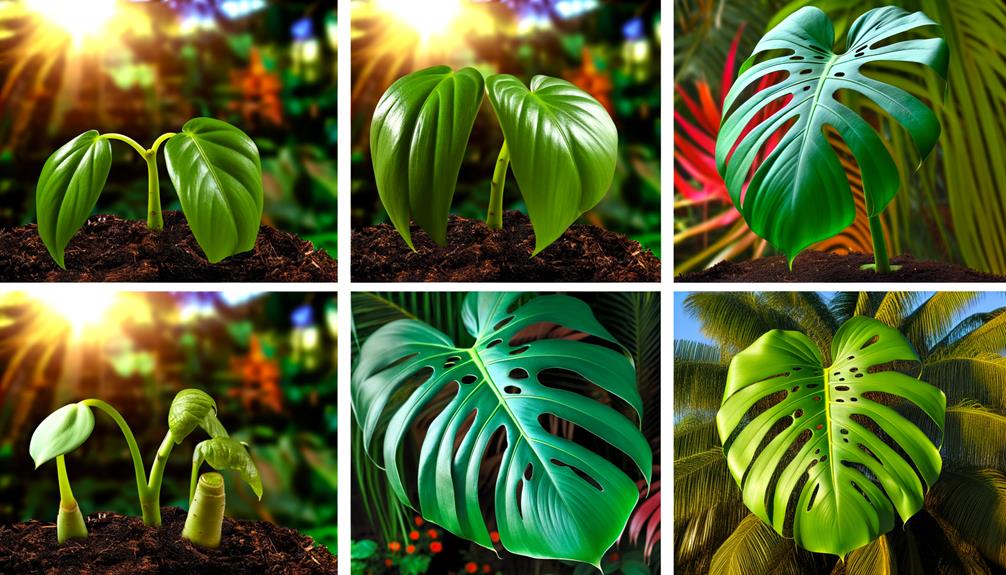
Key Takeaways
- Seed germination involves water uptake, seed coat breaking, and radicle emergence for nutrient absorption.
- Seedling stage features rapid true leaf development and a robust root system for nutrient uptake.
- Early leaf development sees fenestrated leaves and increased chlorophyll concentration for efficient photosynthesis.
- Juvenile foliage has heart-shaped, vibrant green leaves, maximizing photosynthesis for future growth.
- Leaf maturity involves cellular expansion, fenestration development, and increased chloroplast density for photosynthesis maximization.
Monstera Deliciosa Growth Stages: Key Phases in the Life of a Tropical Beauty
| Growth Stage | Description | Key Characteristics |
|---|---|---|
| Seedling Stage | The plant starts as a small seedling after germination. | Small, heart-shaped leaves; delicate growth. |
| Juvenile Stage | The plant develops more leaves and gains height. | Leaves are smaller, without fenestrations (splits). |
| Developing Stage | The plant starts to produce larger, more mature leaves. | Leaves may start to develop fenestrations (slits or holes). |
| Mature Stage | Fully developed leaves with large splits and holes appear. | Monstera’s signature large, perforated leaves are present. |
| Flowering Stage | In its natural environment, it can bloom and produce fruit. | Rare indoors; flowers are white and cone-shaped. |
Seed Germination
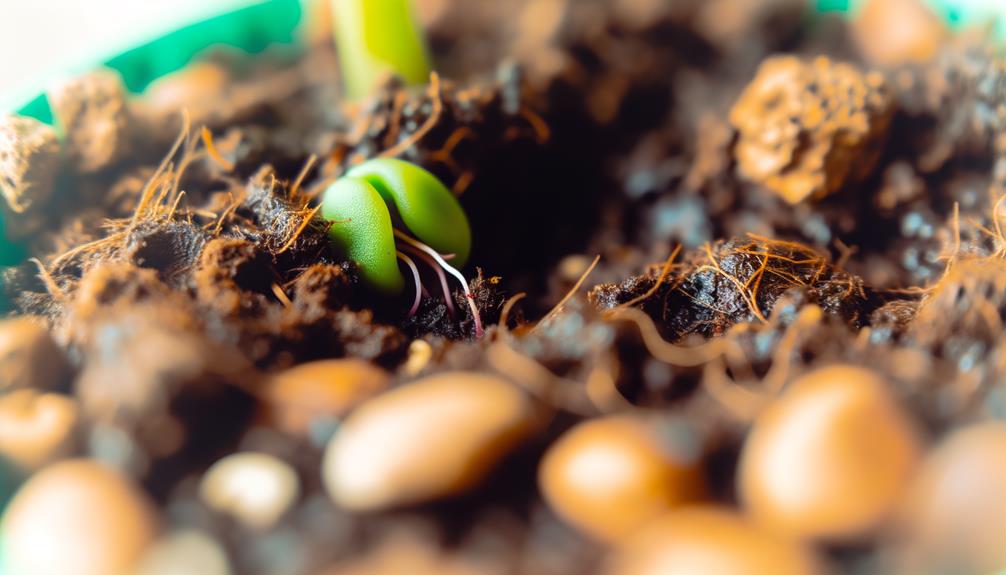
The seed sprouting phase in Monstera deliciosa involves the crucial process of imbibition, where the seed absorbs water, leading to the activation of metabolic pathways essential for growth.
This initial water uptake causes the seed to swell, breaking the seed coat and initiating enzymatic activity. Enzymes such as amylases break down stored starches into simpler sugars, providing the necessary energy for cellular respiration. Concurrently, proteins and lipids are mobilized to support the developing embryo.
This phase is characterized by the emergence of the radicle, the seed’s first root, which anchors the seedling and begins nutrient absorption from the soil. Optimal conditions for sprouting include a warm environment, consistent moisture, and adequate oxygen, ensuring successful progression into subsequent growth stages.
Seedling Stage
Following the successful germination phase, the Monstera deliciosa enters the seedling stage, characterized by the rapid development of its first true leaves and the establishment of a robust root system. During this stage, the cotyledons, or seed leaves, give way to the initial true leaves, which exhibit the plant’s characteristic lobed structure.
The root system expands vigorously, enhancing nutrient and water uptake, which is essential for the seedling’s growth. Ideal conditions, including well-draining soil, consistent moisture, and sufficient light, are crucial for healthy development. Attention to these environmental factors ensures the seedling’s resilience and vitality.
This stage sets the foundation for subsequent growth phases, where the Monstera will further diversify its foliage and develop its distinctive fenestrations.
Early Leaf Development
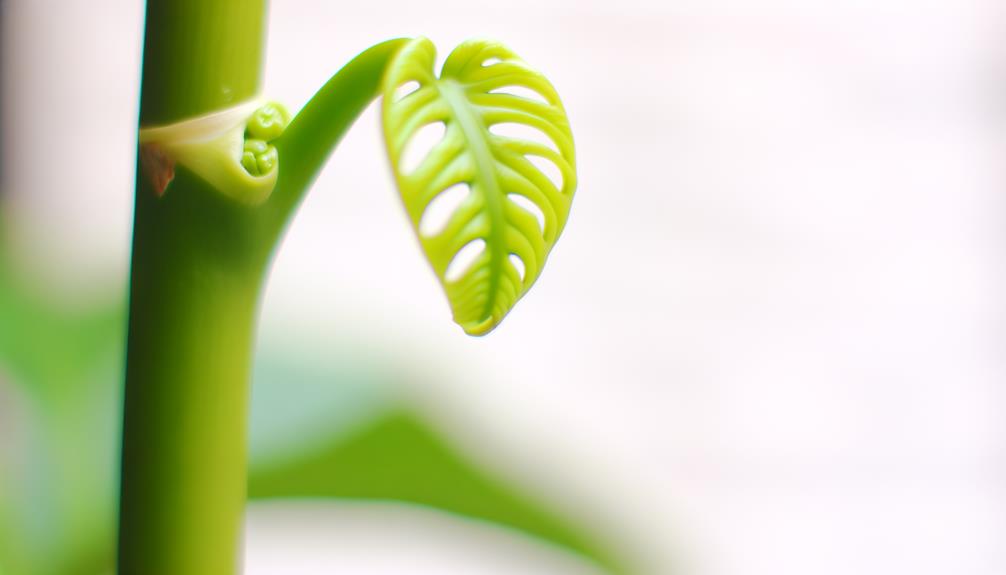
During the early leaf development stage, Monstera deliciosa produces its initial set of larger leaves, which begin to exhibit the characteristic fenestrations and splits unique to mature plants. These morphological changes are influenced by factors such as light intensity, humidity, and nutrient availability.
The presence of fenestrations not only increases the leaf’s surface area for photosynthesis but also aids in reducing wind resistance, an adaptation to its native tropical environments. The leaves emerge from a central stem, unfurling gradually, and their development is indicative of the plant’s overall health.
Chlorophyll concentration increases in these leaves, enhancing their photosynthetic efficiency. This stage is critical for the plant’s energy acquisition, setting the foundation for vigorous future growth.
Establishing Roots
While the early leaf development is a visible indicator of the Monstera deliciosa‘s health, the establishment of a robust root system is equally important for sustaining its growth and stability. Root development begins with the emergence of primary roots, which anchor the plant.
These roots then branch into a network of secondary and tertiary roots, enhancing nutrient and water uptake. The presence of aerial roots, which typically emerge from nodes along the stem, further aids in stability and nutrient absorption. Best root growth requires well-draining soil, consistent moisture, and proper aeration.
Monitoring root health through periodic inspection can prevent issues such as root rot, ensuring the plant’s long-term strength and resilience, thereby creating a strong foundation for subsequent growth stages.
Juvenile Foliage
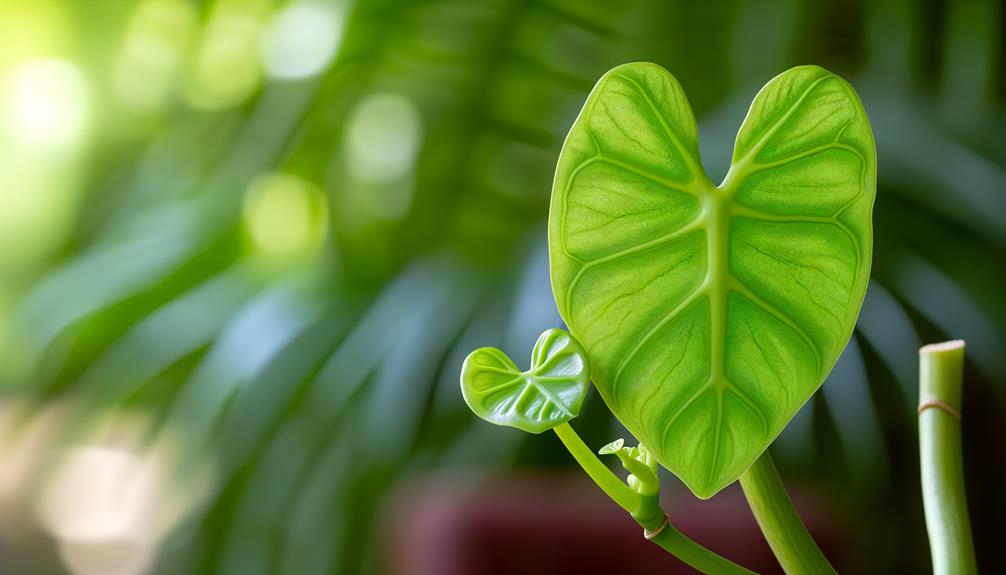
The juvenile foliage stage of Monstera deliciosa is characterized by the development of small, heart-shaped leaves that lack the distinctive fenestrations seen in mature plants. During this stage, the leaves are generally smooth and entire, without the splits or holes that will appear as the plant matures.
These juvenile leaves are typically a vibrant green, reflecting the plant’s vigorous growth and health. This stage is important for the plant’s development, as it allows the Monstera to maximize photosynthesis and establish a robust framework for future growth.
Environmental factors such as light, humidity, and soil nutrients have a significant impact on the rate and quality of leaf development, setting the stage for subsequent morphological changes.
Fenestration Begins
As Monstera deliciosa progresses from its juvenile foliage stage, it enters a phase where fenestration begins, characterized by the initial appearance of splits and holes in the leaves.
This morphological change is vital for the plant’s adaptation, enhancing light capture and reducing wind resistance in its native tropical habitats. Fenestration typically starts when the plant achieves a certain maturity level and is influenced by environmental factors such as light intensity and humidity.
The development of fenestrations signifies a healthy and well-acclimated Monstera, responding to its surroundings by optimizing its leaf structure. Observing this phase is essential for understanding the plant’s growth dynamics and ensuring proper care to promote further healthy development.
Rapid Growth Phase
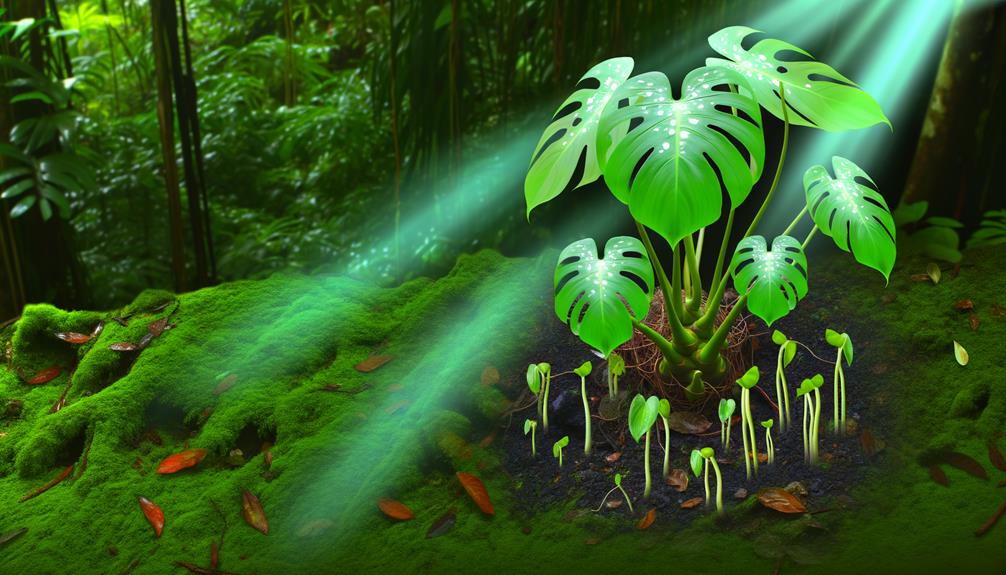
Entering the rapid growth phase, Monstera deliciosa accelerates its vegetative expansion, characterized by vigorous stem elongation and leaf production. During this period, the plant exhibits enhanced photosynthetic activity and nutrient uptake, driven by ideal environmental conditions, including sufficient light, humidity, and temperature.
Root systems expand considerably to support increased nutrient and water demands. Auxin and gibberellin hormones play pivotal roles in promoting internodal elongation and overall biomass accumulation. This phase is marked by a noticeable increase in both the frequency and size of new leaves.
Vigilant care, including consistent watering, balanced fertilization, and proper support for climbing species, is essential to sustain this rapid growth, ensuring the Monstera deliciosa reaches its full potential during this dynamic developmental stage.
Mature Leaves
As Monstera deliciosa reaches maturity, its leaves exhibit marked fenestration patterns, characterized by distinctive splits and holes that enhance photosynthetic efficiency.
The pigmentation of these leaves deepens into a rich, dark green, indicative of robust chlorophyll concentration.
Concurrently, leaf size increases notably, reflecting the plant’s enhanced nutrient uptake and overall health.
Leaf Fenestration Patterns
Leaf fenestration patterns in mature Monstera deliciosa plants are characterized by the development of natural splits and holes that enhance light penetration and air circulation within the foliage. These fenestrations are not merely aesthetic but serve important physiological functions. Specifically, the patterns are a result of genetic and environmental influences that optimize the plant’s adaptability in its native tropical habitat.
Key aspects of leaf fenestration in Monstera deliciosa include:
- Light Optimization: The holes allow sunlight to reach lower leaves, promoting photosynthesis throughout the entire plant.
- Wind Resistance: The splits reduce wind resistance, minimizing damage during strong tropical storms.
- Water Shedding: The patterns help channel rainwater away from the leaf surface, reducing the risk of fungal infections.
Understanding these patterns is essential for proper care and cultivation.
Dark Green Pigmentation
The dark green pigmentation observed in the mature leaves of Monstera deliciosa is primarily a result of increased chlorophyll concentration, which enhances the plant’s photosynthetic efficiency. Chlorophyll is essential for capturing light energy, facilitating the conversion of carbon dioxide and water into glucose and oxygen.
This elevated chlorophyll level not only optimizes energy production but also reflects the plant’s adaptation to lower light conditions in its natural habitat. Additionally, the robust green hue indicates healthy nitrogen levels, a necessary element for chlorophyll synthesis.
The intensified pigmentation serves as a marker of leaf maturity, signaling that the leaf has reached a developmental stage where it can maximize its photosynthetic capacity, thereby supporting the overall growth and well-being of the Monstera deliciosa.
Leaf Size Increase
Mature Monstera deliciosa leaves exhibit a significant increase in size due to the cellular expansion and division processes critical for efficient light capture and photosynthetic efficiency. This growth phase is marked by several key physiological changes:
- Cellular Expansion: Cells in the leaf blade elongate and expand, allowing the leaf to cover a larger surface area to maximize light absorption.
- Fenestration Development: Mature leaves develop characteristic splits or holes, known as fenestrations, which help reduce wind resistance and allow light to reach lower leaves.
- Increased Chloroplast Density: The number of chloroplasts per cell increases, enhancing the plant’s ability to convert sunlight into chemical energy through photosynthesis.
These adaptations collectively enable Monstera deliciosa to thrive in diverse environmental conditions.
Supporting Structures

The selection of suitable support materials, such as moss poles or trellises, is vital to accommodate the natural climbing habit of Monstera deliciosa. Proper installation techniques guarantee that these supports are securely anchored, facilitating ideal growth and stability.
Regular maintenance checks are necessary to uphold the structural integrity, preventing potential damage to the plant as it matures.
Choosing Support Materials
Selecting appropriate support materials is essential for ensuring the healthy vertical growth and structural stability of Monstera deliciosa plants. The choice of support not only influences the plant’s aesthetics but also its physiological development.
Consider the following support materials:
- Moss Poles: These provide a naturalistic climbing surface, retaining moisture which aids aerial root attachment and nutrient uptake.
- Trellises: Available in various materials like wood or metal, trellises offer a rigid framework that can be easily adjusted as the plant grows.
- Coir Poles: Made from coconut fiber, these poles are eco-friendly and offer excellent water retention, promoting robust root establishment.
Each support type offers unique benefits, catering to the Monstera’s climbing nature and enhancing its overall growth and health.
Installing Plant Supports
Correctly setting up plant supports is vital to guarantee the Monstera deliciosa’s optimal growth and structural integrity. Begin by selecting an appropriate support, such as a moss pole or trellis, making sure it is securely anchored in the pot.
The support should extend vertically, encouraging the Monstera to climb naturally. Position the support close to the plant’s base, minimizing disturbance to the roots. Secure the plant to the support using soft ties or plant clips, avoiding any constriction that may harm the stem. Ensure the ties are adjustable to accommodate growth.
The support must be stable and capable of bearing the plant’s increasing weight. Proper installation facilitates aerial root attachment, enhancing nutrient and moisture absorption, necessary for the Monstera’s development.
Maintaining Structural Integrity
Maintaining the structural integrity of Monstera deliciosa involves regular assessments and adjustments to the supporting structures to accommodate the plant’s dynamic growth and morphological changes. Given its propensity to develop extensive aerial roots and large fenestrated leaves, effective support is essential.
Here are three key guidelines:
- Regular Checks: Frequently inspect for signs of stress or instability in the plant and its supports to proactively address potential issues.
- Flexible Ties: Use adaptable, adjustable plant ties that can be loosened or tightened as the plant grows, preventing damage from restricted growth.
- Strong Stakes: Utilize sturdy, durable stakes or trellises to provide a stable framework that can bear the weight of mature Monstera leaves and stems.
These practices guarantee healthy and sustained growth.
Environmental Factors
The growth and health of Monstera deliciosa are greatly influenced by various environmental factors. These include light intensity, humidity levels, temperature ranges, and soil composition.
Ideal light intensity, typically bright indirect light, ensures strong photosynthesis without leaf burn. Humidity levels between 60-80% support proper stomatal function and prevent desiccation. Temperature ranges of 18-27°C (65-80°F) are best, as extreme temperatures can hinder enzymatic activities essential for growth.
Soil composition should be well-draining yet moisture-retentive, with a pH range of 5.5 to 7.0, to facilitate nutrient uptake and root health. These variables must be accurately managed to promote the Monstera deliciosa’s vigorous development and lush foliage, reflecting the plant’s natural tropical habitat.
How Long Do Monstera Deliciosa Plants Live
Monstera deliciosa plants can live for many decades if properly cared for. In ideal conditions with consistent watering, indirect light, proper humidity, and occasional fertilization, these tropical plants can thrive and continue to grow for 40 years or more. Their lifespan in homes can be much longer with the right care, though they may not reach the same size or maturity as in their natural environment.
Regular pruning, repotting, and ensuring they are not exposed to extreme conditions will also help extend their lifespan. Monstera deliciosa is known for its ability to grow large, fenestrated leaves as it matures, which makes it a long-lasting and visually striking houseplant.
How Often Do Monstera Deliciosa Grow New Leaves
Monstera deliciosa typically grows new leaves every 4 to 6 weeks under optimal conditions, especially during the growing season, which is spring and summer. Factors such as light, temperature, humidity, watering, and overall plant health can influence the frequency of new leaf growth.
If the plant is receiving bright, indirect light and proper care, it may produce a new leaf every month. Growth usually slows down in the fall and winter as the plant enters a more dormant phase. You can encourage more frequent leaf growth by ensuring proper care and a suitable environment for the plant.
Conclusion
The growth stages of Monstera deliciosa, from seed germination to mature leaves, demonstrate a complex and dynamic development process influenced by both intrinsic genetic factors and extrinsic environmental conditions.
Each stage, from seedling to mature foliage, involves critical physiological and morphological changes that support the plant’s survival and adaptability.
Understanding these stages provides valuable insights into best cultivation practices and highlights the intricate interplay between growth phases and environmental factors, ultimately contributing to more efficient horticultural management strategies.






